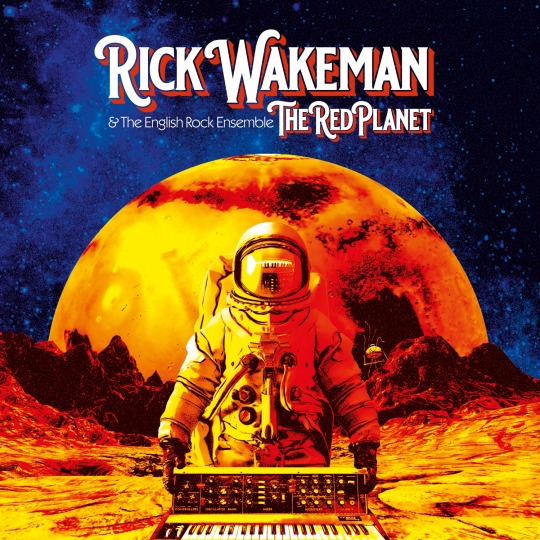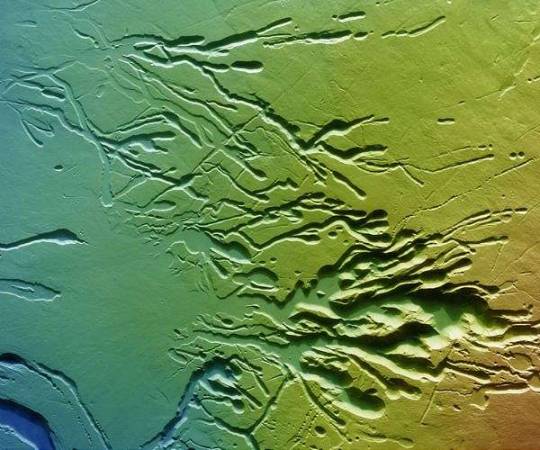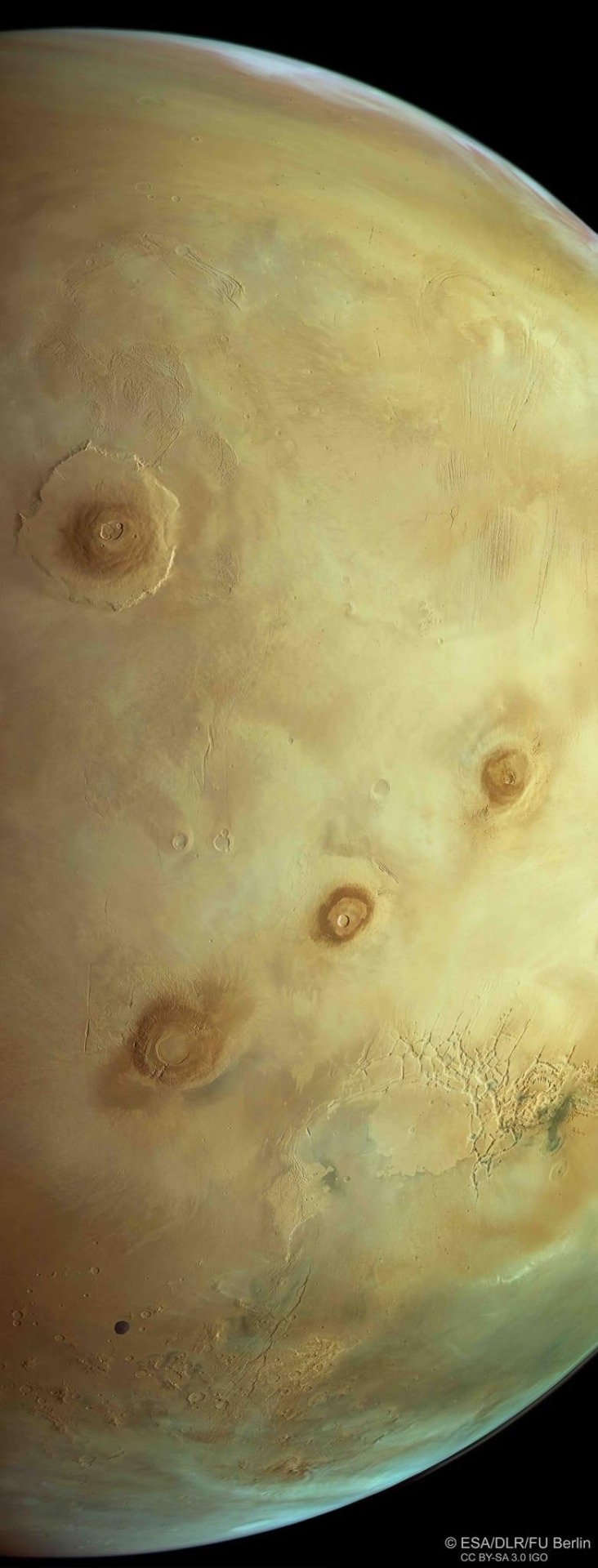#Ascraeus Mons
Video
Perspective view of Mars’s Tharsis volcanoes by European Space Agency
Via Flickr:
This oblique perspective view shows a slice of Mars imaged to mark a milestone for ESA’s Mars Express: its 25 000th orbit around the Red Planet. It was generated from a digital terrain model and the nadir (downward-pointing) and colour channels of Mars Express’s High Resolution Stereo Camera. The vertical scale is exaggerated by a factor of approximately three, making the volcanoes look three times higher than they are in real life. Three of Mars’s famously colossal volcanoes are shown here: from left to right, Arsia, Pavonis and Ascraeus Mons. The mound of Mars’s largest volcano, Olympus Mons, can be spied further away at the top of the frame, while the fractured terrain of Noctis Labyrinthus, Mars’s ‘labyrinth of night’, can be seen in the foreground. Read more [Image description: This image shows a tan-coloured portion of Mars, with the curvature of the planet visible to the top left the frame. Four of Mars’s volcanoes can be seen in relief against the dark background, shown as darker mounds stretching away from the viewer.] Credits: ESA/DLR/FU Berlin, CC BY-SA 3.0 IGO
#ESA#European Space Agency#Space#Universe#Cosmos#Space Science#Science#Space Technology#Tech#Technology#Mars#Dunes#Panorama#Marte#Solar System#Sol#Mars Express#HRSC#High Resolution Stereo Camera#DLR#Red Planet#Exploration#Phobos#Volcano#Arsia Mons#Pavonis Mons#Ascraeus Mons#Olympus Mons#Noctis Labyrinthus#flickr
3 notes
·
View notes
Photo

7:56 PM EST February 3, 2024:
Rick Wakeman - "Ascraeus Mons"
From the album The Red Planet
(June 19, 2020)
Last song scrobbled from iTunes at Last.fm
Thanks go out to The English Rock Ensemble, obviously.
--

0 notes
Text

I'm very comforted by the idea that somewhere on the slopes of ascraeus mons, there lives a 6'3 woman with callused hands and a husky voice who heats her coffee on the exhaust of the fusion reactor and knows how to cheat at poker by noticing the reflections in the helmet of someone's pressure suit.
#if your sci fi setting doesnt have rednecks in it it's woefully unrealistic#whenever there's a new place rednecks are gonna be the first ones to make it home#they're like lichen in this way
57 notes
·
View notes
Text

Lava Flows On Ascraeus Mons Volcano, Mars (April 28, 1998)
#krakenmare#astronomy#astrophotography#solar system#outer space#space#nasa#thank you nasa#mars#mars volcano#volcano
46 notes
·
View notes
Text

“Ascraeus Mons at Sunset on Mars” by Ren Wicks, late 1970s
137 notes
·
View notes
Photo

Topography of Ascraeus Mons by europeanspaceagency https://flic.kr/p/2ozjtKn
19 notes
·
View notes
Photo

Chasms on the flanks of a Martian volcano Mars has some of the most impressive volcanoes in the Solar System. ESA's Mars Express has now imaged the pitted, fissured flank of the planet's second-tallest: Ascraeus Mons. This image comprises observations from Mars Express' High Resolution Stereo Camera (HRSC). Ascraeus Mons is the northernmost and tallest of three prominent volcanoes found in the Tharsis region of Mars, a volcanic plateau in Mars' western hemisphere. It measures a towering 18 km in height but its slopes are gentle, with an average incline of 7 degrees. This slow climb is reflected in the volcano's huge base diameter of 480 km, giving it a footprint roughly the size of Romania on Earth. Ascraeus Mons is surpassed in height only by Olympus Mons, the tallest volcano not only on Mars but in the entire Solar System. Like ink into water The image shows the lower southern flank of Ascraeus Mons. There is a dramatic difference in elevation from one side to the other, with the left (southern) side of the frame sitting about 10 km lower than the right (northern) side. The volcano's peak is found to the right (north) of the frame, as seen most clearly in the wider context map of the region. Many similarly dramatic features - collectively named Ascraeus Chasmata, encompassing an enormous patch of collapsed terrain over 70 km across - are visible across the frame: lava flows and tubes, chains of craters, channel-like rilles, and large fissures spanning tens of km in length. All of different age and origin, these features knit together to form a scene resembling trails of ink dispersing artfully in water, or a plant's beautifully complex root system as it digs down into soil. Lurking below ground To the right side of the frame lie numerous wrinkled lava flows. This crinkled ground then encounters chains of 'pit craters': features where strings of circular or near-circular depressions have combined and coalesced to form troughs. We see these on Earth too, with a notable example being the dramatic Cenotes found on the Yucatan Peninsula, Mexico. The pit crater troughs and chains shown here have also grouped together to form an especially large and eye-catching collapse area. These chains and troughs likely form where hidden voids lie below the surface, causing ground to become unstable and collapse - a bit like a sinkhole. The subsurface voids are thought to be created as the surface layer of a lava flow rapidly cools and hardens; the lava flow beneath then ceases and ebbs away over time, leaving tube-shaped pockets of space lurking several metres below ground. The ground to the left of the pit crater chains is marked by so-called 'sinuous rilles': smaller, snaking channels without rims that are often found at the flanks of volcanoes. It is still unclear how these form, but their creation may involve flows of lava, ash or water - or a combination of the three. The leftmost part of the image is dominated by large fissures of up to 40 km long. Branching out from these fissures are channels that weave and braid together ('braided channels'), isolating chunks of martian terrain to form 'islands' and terraces. These are likely to have formed by water - perhaps as snow and ice built up on the flanks of Ascraeus Mons before later melting away. Exploring Mars Mars Express has been orbiting the Red Planet since 2003, imaging Mars' surface, mapping its minerals, identifying the composition and circulation of its tenuous atmosphere, probing beneath its crust, and exploring how various phenomena interact in the martian environment. The orbiter's HRSC, responsible for these new images, has revealed much about Mars' diverse surface features, with images showing everything from wind-sculpted ridges and grooves to impact craters, tectonic faults, river channels and ancient lava pools. Many Mars Express images feature the Red Planet's immense volcanoes, of which Ascraeus Mons is a fascinating example. The mission's High Resolution Stereo Camera (HRSC) was developed and is operated by the German Aerospace Center (Deutsches Zentrum fur Luft- und Raumfahrt; DLR). IMAGE....This colour-coded topographic image shows the southern flanks of Ascraeus Mons, the second-tallest volcano on Mars. It was created from data collected by ESA's Mars Express on 5 April 2022 during orbit 24045. It is based on a digital terrain model of the region, from which the topography of the landscape can be derived. Lower parts of the surface are shown in blues and purples, while higher altitude regions show up in whites and reds, as indicated on the scale to the top right.
2 notes
·
View notes
Text


(Abrir imagen para apreciar la foto completa)
Hace 1 año el Mars Express celebraba 25.000 órbitas alrededor de Marte. Como parte de la celebración, el orbitador capturó una vista espectacular del Planeta Rojo para conmemorar la ocasión.
La nueva vista a gran altitud fue tomada por la cámara estéreo de alta resolución (HRSC) de Mars Express. Presenta muchos de los imponentes volcanes de Marte e incluso incluye una aparición sorpresa de la luna más grande del planeta, Fobos.
Mars Express llegó a Marte a finales de 2003 y completó su órbita número 25.000 el 19 de octubre de 2023. En las dos décadas transcurridas desde su llegada, el orbitador ha transformado completamente nuestra comprensión del planeta. Ha cartografiado la atmósfera de forma más completa que nunca, ha rastreado la historia del agua en la superficie de Marte, ha estudiado las dos pequeñas lunas marcianas con un detalle sin precedentes y ha proporcionado impresionantes vistas del planeta en tres dimensiones.
Esta nueva imagen no es una excepción. Se centra en la región de Tharsis, que cubre aproximadamente una cuarta parte de la superficie del planeta y alberga los famosos y colosales volcanes de Marte. Aquí se pueden ver muchos volcanes: Olimpo, Arsia, Pavonis y Ascraeus Mons, y Jovis, Biblis y Ulysses Tholus. Olympus Mons es el más grande y alcanza casi 22 km de altura (en comparación con los 8,8 km del Monte Everest aquí en la Tierra).
https://www.esa.int/Science_Exploration/Space_Science/Mars_Express/Mars_Express_celebrates_25_000_orbits
0 notes
Text
Τα 8 ψηλότερα βουνά του ηλιακού μας συστήματος
Pavonis Mons: είναι ηφαίστειο του Άρη και έχει ύψος 14 χιλιόμετρα
Elysium Mons: βρίσκεται στον Άρη και το ύψος του είναι 14.1 χιλιόμετρα
Arsia Mons: είναι ηφαίστειο του Άρη και έχει ύψος 18 χιλιόμετρα
South Boosaule Mons: βρίσκεται στο IO, το οποίο είναι φεγγάρι του Δία και το ύψος του είναι 17.5 χιλιόμετρα
Ascraeus Mons: είναι ηφαίστειο του Άρη με ύψος 18.2 χιλιόμετρα
Equatorial Ridge:…

View On WordPress
0 notes
Text
Woke White People and Privileged Kids UNLESS YOU'RE MARTIAN YOU CAN'T HAVE A USER NAME WITH A MARTIAN CONNECTION, EAT MARTIAN FOOD, LISTEN TO MARTIAN MUSIC, OR ENJOY MARTIAN MUSIC OR I WILL CALL YOU RACIST!
People who grew up on Mars, have Martian passports, and spend a lot of time with Martian people- whatever dude, I got to meet my Martian nana at Ascraeus Mons for dinner.
0 notes
Text
China's Mars spacecraft has photographed the entire red planet, state media says
China’s Mars spacecraft has photographed the entire red planet, state media says
China’s Mars orbiter captured this top-down view of the 59,055-foot Ascraeus Mons volcano.CNSA/Handout via Reuters
China‘s Mars orbiter has imaged the entire red planet, according to state media.
The Tianwen-1 mission — the orbiter and a rover — met its scientific goals, state media said.
The spacecraft’s pictures reveal vast craters, canyons as long as the US, and a volcano on Mars.
China’s…

View On WordPress
0 notes
Photo

Ascraeus Mons, Mars 2005
3 notes
·
View notes
Photo

5:34 AM EDT April 9, 2022:
Rick Wakeman - "Ascraeus Mons"
From the album The Red Planet
(June 19, 2020)
Last song scrobbled from iTunes at Last.fm
Thanks go out to The English Rock Ensemble, obviously.
--

1 note
·
View note
Photo

HiPOD 13 Oct 2021: Impact Craters as Windows to What Lies Beneath
Impact craters are common on all solar system bodies. They offer many clues to scientists regarding the geologic history of a planetary surface, particularly regarding its age, evolution with time, and composition.
For instance, this image covers an impact crater on the southeastern flank of Ascraeus Mons, a notable volcano in the Tharsis Plateau. Based on the original science rationale for acquiring this image, by gaining more information about its depth and consequently the stability of the crater wall we can learn more about the nature of the volcano’s flank materials.
Also, by carefully studying the materials exposed in the crater walls, we can gain more information about the subsurface.
Image is less than 5 km across and is 269 km above the surface.
NASA/JPL/UArizona
50 notes
·
View notes
Text
火星表面发现两个深坑最大直径超300米(图)
北京时间12月27日消息,据美国国家地理网站报道,美国宇航局2010年12月发布了火星侦察轨道飞行器HiRISE相机拍到的土星最新照片,显示了火星表面一些令人好奇的地质特征。每张照片都覆盖火星上跨度为3.7英里(约合6公里)的一片区域,揭示了火星表面小如办公桌的地质构造细节,其中,两个大坑最令科学家感兴趣。
1.火星表面大坑
火星表面大坑
在美宇航局火星侦察轨道飞行器(MRO)2010年10月1日和11月1日间拍摄的一张照片上,两个大坑就像太空蛞蝓的藏身之处一样,在火星火山艾斯克雷尔斯山(Ascraeus Mons)附近布满尘埃的平原留下了痕迹。一年前,火星侦察轨道飞行器的姊妹探测器“火星奥德赛”号(Mars…

View On WordPress
1 note
·
View note
Photo

Martian Landscape: Lava Channels-Collapsed lava tubes make snake-like tracks on the flank of the large volcano Ascraeus Mons on Mars.
61 notes
·
View notes